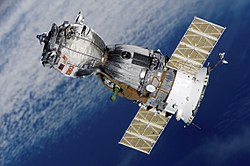This article needs additional citations for verification .(December 2013) |
 The Soyuz TM-19 landing capsule on display at the Technik Museum Speyer | |
| Mission type | Mir crew transport |
|---|---|
| Operator | Rosaviakosmos |
| COSPAR ID | 1994-036A |
| SATCAT no. | 23139 |
| Mission duration | 125 days, 22 hours, 53 minutes, 36 seconds |
| Orbits completed | 1,993 |
| Spacecraft properties | |
| Spacecraft | Soyuz 7K-STM No.68 [1] |
| Spacecraft type | Soyuz-TM |
| Manufacturer | RKK Energia |
| Launch mass | 7,150 kilograms (15,760 lb) |
| Crew | |
| Crew size | 2 up 3 down |
| Members | Yuri Malenchenko Talgat Musabayev |
| Landing | Ulf Merbold |
| Callsign | Ага́т (Agat - Agate) |
| Start of mission | |
| Launch date | July 1, 1994, 12:24:50 UTC |
| Rocket | Soyuz-U2 |
| Launch site | Baikonur 1/5 |
| End of mission | |
| Landing date | November 4, 1994, 11:18:26 UTC |
| Landing site | 88 kilometres (55 mi) northeast of Arkalyk |
| Orbital parameters | |
| Reference system | Geocentric |
| Regime | Low Earth |
| Perigee altitude | 396 kilometres (246 mi) |
| Apogee altitude | 397 kilometres (247 mi) |
| Inclination | 51.6 degrees |
| Period | 92.48 minutes |
| Epoch | 31 July 1994 [2] |
| Docking with Mir | |
| Docking port | Kvant-1 aft |
| Docking date | 3 July 1994, 13:55:01 UTC |
| Undocking date | 4 November 1994, 08:31:30 UTC |
 Soyuz programme (Crewed missions) | |
Soyuz TM-19 was a crewed Soyuz spaceflight to space station Mir that carried Russian cosmonaut Yuri Malenchenko and Kazakh cosmonaut Talgat Musabayev, while also landing German astronaut Ulf Merbold. It launched on 1 July 1994, at 12:24:50 UTC. [3]

